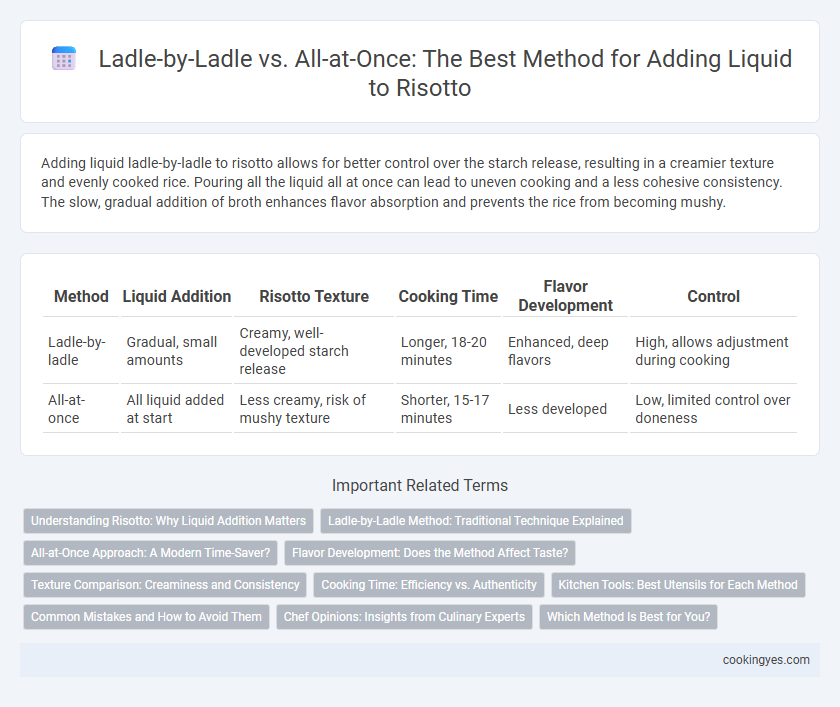Adding liquid ladle-by-ladle to risotto allows for better control over the starch release, resulting in a creamier texture and evenly cooked rice. Pouring all the liquid all at once can lead to uneven cooking and a less cohesive consistency. The slow, gradual addition of broth enhances flavor absorption and prevents the rice from becoming mushy.
Table of Comparison
| Method | Liquid Addition | Risotto Texture | Cooking Time | Flavor Development | Control |
|---|---|---|---|---|---|
| Ladle-by-ladle | Gradual, small amounts | Creamy, well-developed starch release | Longer, 18-20 minutes | Enhanced, deep flavors | High, allows adjustment during cooking |
| All-at-once | All liquid added at start | Less creamy, risk of mushy texture | Shorter, 15-17 minutes | Less developed | Low, limited control over doneness |
Understanding Risotto: Why Liquid Addition Matters
Ladle-by-ladle liquid addition in risotto ensures gradual starch release from Arborio rice, creating the desired creamy texture critical for authentic risotto. Adding liquid all at once can dilute starch concentration, resulting in a less cohesive, watery consistency that lacks the classic velvety mouthfeel. Mastering ladle-by-ladle technique optimizes liquid absorption and starch gelatinization, key factors for perfect risotto texture and flavor balance.
Ladle-by-Ladle Method: Traditional Technique Explained
The ladle-by-ladle method for adding liquid to risotto involves gradually incorporating warm broth one ladle at a time, allowing the rice to fully absorb the liquid before adding more. This traditional technique ensures a creamy texture by releasing the rice's starch slowly, resulting in a perfectly al dente finish. Consistent stirring during ladle additions promotes even cooking and prevents the rice from sticking or becoming mushy.
All-at-Once Approach: A Modern Time-Saver?
The all-at-once approach to risotto abolishes traditional incremental liquid addition, pouring the entire broth into the rice at once, significantly reducing stirring time. This modern method leverages precise temperature control and high-quality, starchy Arborio rice to maintain the creamy texture Risotto is known for. Experimental culinary studies suggest this technique offers a reliable, time-saving alternative without compromising flavor or consistency.
Flavor Development: Does the Method Affect Taste?
Ladle-by-ladle liquid addition in risotto promotes gradual starch release, enhancing creaminess and depth of flavor through continuous absorption and evaporation. All-at-once pouring risks uneven cooking and a less integrated taste due to rapid liquid saturation and reduced stirring. Most chefs favor the ladle-by-ladle technique for superior texture and nuanced, well-developed flavor profiles in traditional risotto preparation.
Texture Comparison: Creaminess and Consistency
Ladle-by-ladle liquid addition in risotto promotes gradual starch release from Arborio rice, resulting in a creamier and more velvety texture with consistent thickness. All-at-once liquid pouring can lead to uneven starch extraction, causing a less cohesive consistency with potential sticky or soupy patches. For optimal risotto creaminess and uniform texture, the traditional ladle-by-ladle technique remains superior.
Cooking Time: Efficiency vs. Authenticity
Ladle-by-ladle liquid addition in risotto ensures even starch release, creating a creamy texture but requires longer cooking time, appealing to traditionalists seeking authentic results. All-at-once liquid addition significantly reduces cooking time, enhancing efficiency for busy cooks while risking a less creamy and unevenly cooked risotto. Choosing between methods depends on balancing speed against the desire for the classic, rich consistency characteristic of authentic risotto preparation.
Kitchen Tools: Best Utensils for Each Method
Ladle-by-ladle liquid addition in risotto requires precise control, making a sturdy, heat-resistant ladle the best kitchen tool for gradual stirring and gradual absorption. For the all-at-once method, a heavy-bottomed saucepan combined with a long-handled wooden spoon optimizes even heat distribution and consistent stirring. Choosing utensils designed for heat durability and ergonomic handling ensures smooth cooking, whether the liquid is added incrementally or all at once.
Common Mistakes and How to Avoid Them
Adding all the liquid at once in risotto often leads to uneven cooking, resulting in mushy rice or undercooked grains. Common mistakes include insufficient stirring and rapid temperature changes that prevent gradual starch release, crucial for the creamy texture. To avoid these issues, add broth ladle by ladle, allowing the rice to absorb liquid slowly while stirring constantly for perfect consistency.
Chef Opinions: Insights from Culinary Experts
Chef experts widely favor the ladle-by-ladle technique for risotto, emphasizing its superior ability to control the gradual absorption of liquid, which enhances the creamy texture and prevents overcooking. Culinary authorities highlight that adding broth all at once risks uneven cooking and a less consistent risotto outcome. The ladle-by-ladle method also allows chefs to fine-tune seasoning and adjust the liquid amount based on rice texture observations, ensuring optimal flavor and consistency.
Which Method Is Best for You?
Ladle-by-ladle liquid addition in risotto ensures precise control over the starch release and creaminess, ideal for cooks seeking a traditional, hands-on approach that results in a perfectly textured dish. The all-at-once method offers speed and simplicity, suitable for those who prefer a quicker preparation without constant stirring, though it may sacrifice some of the classic creamy consistency. Choosing the best method depends on whether you prioritize authentic texture and flavor development or convenience and time efficiency in your cooking routine.
Ladle-by-ladle vs All-at-once for liquid addition Infographic

 cookingyes.com
cookingyes.com